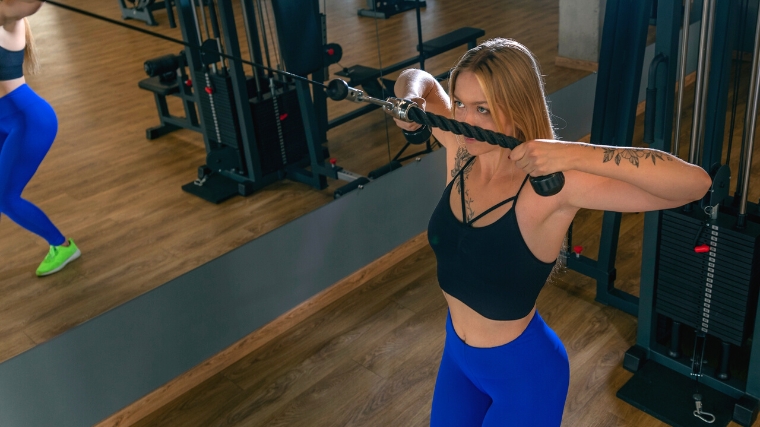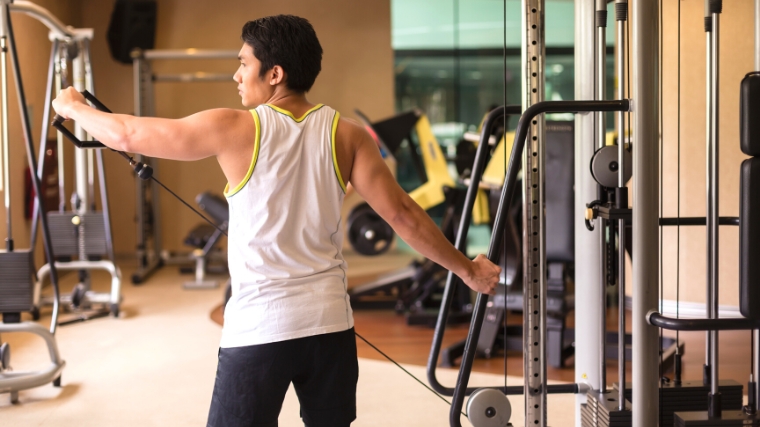You’re probably in the market for some capped delts. Full, round shoulders that pop from every angle can help define your physique, so nailing your delt days in the gym is an absolute must.
Building your shoulders can be as easy as hammering them with a more blunt instrument like dumbbells or barbells, sure — but you can also get a bit more surgical in your approach. Utilizing cables can be just the trick to stimulate ongoing growth and give you the edge needed to more precisely smoke any lagging tissue.

Here’s how to use a cable shoulder workout as your one-stop shop for all things deltoid.
Best Cable Shoulder Workouts
- Cable Shoulder Workout for Beginners
- Cable Shoulder Workout for Intermediates
- Cable Shoulder Workout for Advanced Lifters
Cable Shoulder Workout for Beginners
Cables are a great tool to train the shoulders, whether you’re a rank beginner taking your first steps in the weight room or have been at it for years. You can select your exercises for their potential to build muscle mass and set the proverbial table for long-term progress down the road.
Utilizing cables to train each section of your shoulders while also challenging your stability is a huge asset during your foundational workouts.
The Workout
A cable shoulder press of some sort should be the cornerstone of your early sessions. Presses can help target all heads of your deltoids and allow you to focus on other aspects of stability or range of motion with complementary exercises.
Pair these choices with moderate to higher repetition ranges and a slow tempo. This way, you’ll feel some serious shoulder burn while building all the stability you need for the future.
- Seated Cable Shoulder Press: 3 x 12
- Cable Reverse Fly: 2 x 15
- Cable Y-Raise: 2 x 15
Coach’s Tip: A tempo prescription in this case would entail lowering the weight for three seconds, pausing for a beat, pushing as hard as possible for about one second, and then resting at the top for a moment to collect yourself.
Cable Shoulder Workout for Intermediates
Once you’ve progressed to a more intermediate level, your stability needs should stand aside somewhat in lieu of raw effort.
At this stage, you should be able to kick up your training intensity and work across a variety of set and repetition ranges for the purposes of muscle building and general work capacity. You’ll also be able to layer in an exercise or two which can more precisely target any of the individual heads of the deltoids.
The Workout
Cables are a fantastic way to retain much of your stability once you’ve built a solid foundation. Breaking up your shoulders into three main angles of attack — a press (or front raise), lateral raise, and reverse flye — should be all you need.
The amount of time spent in your workout stabilizing the cables while you go to town on each section of the deltoids should cover all bases.
- Seated Cable Shoulder Press: 3 x 8-10
- Cable Lateral Raise: 4 x 12-15
- Cable Reverse Fly: 2 x 15
Cable Shoulder Workout for Advanced Lifters
As you enter an advanced level of training, you should probably consider giving each of the three heads of the deltoid some direct attention. Pressing will still be a valuable exercise, but beating up your shoulders with endless sets of presses might not cut it.
Instead, convert some of your programming volume into more precise accessory movements to continue to drive growth.
The Workout
You won’t be able to continuously keep progressing your presses — or your rear delt work, for that matter — with added weight forever. You’re likely to hit diminishing returns somewhere, so it will be more productive to expand your repertoire of exercises. Luckily, cables can accommodate just about any shoulder movement out there and allow you to keep plowing forward.
- Seated Cable Shoulder Press: 2 x 8-10
- Cable Front Raise: 2 x 10-12
- Cable Lateral Raise: 3 x 10-12
- Cable Rear-Delt Row: 3 x10-12
How to Progress Cable Shoulder Workouts
Progressing cable shoulder workouts can be as easy as manipulating repetition ranges, adding volume or frequency, or pairing your final sets with some intensifiers. Here’s how to tweak these factors to your advantage in the gym.
Adjust Your Repetition Ranges
Regarding stability, cables land right in the middle between fully-stabilized machines and independent free weights. A machine will be in a fixed range of motion meaning you’ll only need to worry about producing force; whereas, a free weight must be completely stabilized by you before producing force. Cables offer some stability but still challenge you with a ton of variability.
As such, you can progress your cable workouts by starting with higher repetitions. Higher repetition sets would be typically associated with a lighter or more manageable weight. This will help you improve your stability and coordination, all the while slowly and sneakily adding weight to certain exercises.
Adjust Volume and Frequency
Another way to improve your shoulder development is to increase total volume or training frequency per week (or a combination of the two). Total training volume has been long associated with improved muscle building; you should aim to hit at least 10 high-quality weekly sets for a given muscle group, with the efficacy beginning to taper off above 15 or so. (1) Note, though, that these prescriptions vary wildly between individuals.

As you increase your training volume, it will likely be beneficial to also consider splitting your shoulder training up into multiple sessions per week. Splitting 10 or more sets of shoulders between two training sessions will likely allow for higher intensity per session.
Should your training volume start to climb a bit higher, spreading out those sets will also keep your workouts from getting too long.
Include Intensifiers
If you’re an intermediate athlete or are wrapping up several months of programming, you can consider throwing in some intensifiers during your cable shoulder workouts. Utilizing drop sets is a great way to assure that you’re really peaking your effort by the end of a training session.
When you’ve progressed repetitions, volume, and frequency, consider spicing things up with a few intensified sets per muscle group as the icing on the cake.
Benefits of Cables
Cables are one of the most widely-applicable pieces of gym equipment. They allow you to really chisel out the right angles for each muscle group, accommodate individual structural considerations, and are much easier to work with than some other implements.
They Provide Constant Tension
Mechanical tension is one of the most important factors for creating muscle growth. Many free weight shoulder exercises (think lateral raises, for instance) have inconsistent resistance curves; they’re easy in the first half, but are too difficult in the second half, or vice-versa.
Cables let you circumvent this issue, since you aren’t lifting the weight against the downward force of gravity alone. In this way, cables gain points for their unique application of tension that you can’t find elsewhere in the gym.
Cables Hit Every Angle
When you’re trying to build a sweet set of delts, being able to line your exercises up to the muscle of interest is a huge asset. Cables are a unique tool that allow for a ton of variability in how they can be arranged (think the height of the pulley itself or the angle you’re pulling from).
Where other tools such as machines or free weights may be a bit restrictive, cables are often the best solution to hit all the right angles. If you’re training shoulders with cables, take a few extra minutes to find the right angle for your body.
They’re Accommodating to Your Structure
While cables can be adjusted to match your bodily structure on a given exercise, machines and free weights might be a bit too unforgiving on your physical structure. While a good shoulder press machine can be a solid choice to build the delts, it’s fruitless if your arm or torso length don’t match the design. If you experience pain or discomfort when using a shoulder press machine that you can’t adjust, the station isn’t really of use to you.
Cables, on the other hand, can accommodate your unique anatomical design. From limb length, torso size, or anything in between, a cable stack can likely give you access to all the exercises you need.
Cables Provide Alternate Progression Pathways
The versatility of cable stations affords you multiple options for intensifying or progressing a given exercise or workout. With free weights, you’re often constrained to simply adding additional weight, since you have to push against gravity only.
Cables, on the other hand, give you more freedom, particularly for the shoulders. You can extend your range of motion or utilize long-lever exercises like flye variations. The constant tension from the cable itself also allows you to progress your total rep count and still make progress.
Anatomy of the Shoulder
To build the best set of shoulders possible, identifying the three major divisions and training them with an appropriate level of focus will be extremely helpful.
Anterior Deltoid
The anterior deltoid is the front of your shoulder. It can be found on the lateral most section of your collar bone and inserts just about dead center of your humerus (upper arm) on the deltoid tuberosity. Given its location, exercises that flex the shoulder (front raise) or pressing patterns (both bench and shoulder pressing) hits the anterior deltoid quite effectively.
In many programs, the anterior deltoid will require the least direct focus because it is highly synergistic with other exercises. You may be able to grow your anterior shoulder just fine if you train your chest on a regular basis.
Medial Deltoid
The medial deltoid sits right in the middle of the three major shoulder muscles. It can be found attached at the acromion process which is part of your scapula, close to the outermost tip of your collarbone. It then attaches to the deltoid tuberosity found in the middle of the upper arm bone.

Given where this part of your shoulder muscle is located, lateral raising motions are your biggest tool for developing the medial deltoid. To build your medial delt, you’ll generally need to perform lateral raises of some form, since the muscle doesn’t lend itself well to large compound exercises.
Posterior Deltoid
The back of the shoulder is often overlooked, but developing the posterior deltoid is truly crucial in creating a full round look. It can be found on the inferior aspect of the spine of your scapula (the shoulder blade) and attaches to the deltoid tuberosity of the outer side of the upper arm.
The rear delt helps stabilize your scapula, but it’s hard to isolate on its own. You’ll need to abduct, or draw outward, your upper arm, such as rear flyes, face pulls, or banded pull-aparts.
Go Build Some Boulders
The shoulders are all about angles. With three smaller muscles making up this major muscle group, you need the right tool for the job…like a cable station. Lining up your exercises as precisely as you can will help you divvy up the stimulus with a little more accuracy.
Machines and free weights can be effective in their own right, but they unfortunately lack customizability and comfort. Once you load up a few sets on a solid press, pursue an epic burn with extreme precision on each of the anterior, medial, and posterior deltoids for the best results.
References
1. Schoenfeld, B. J., Contreras, B., Krieger, J., Grgic, J., Delcastillo, K., Belliard, R., & Alto, A. (2019). Resistance Training Volume Enhances Muscle Hypertrophy but Not Strength in Trained Men. Medicine and science in sports and exercise, 51(1), 94–103.
Featured Image: Kzenon / Shutterstock